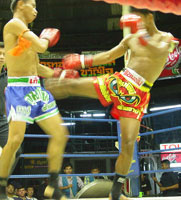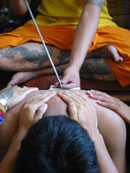Muay Thai
Muay Thai, otherwise known as Thai boxing, is the beloved national sport of Thailand. Although it is similar to western-style boxing, the posture, stance and rules of Muay Thai are quite different. Perhaps the most well-known Muay Thai moves are the powerful sweeping kicks delivered by boxers who have desensitised their shins by repeatedly smashing them against banana trees or punching bags. Elbows and knees play the most important part in a match and are used to deliver devastating blows to the opponent’s head and body. Pretty much anything goes during a match; only the head cannot be used to deliver blows to an opponent. Attending a Muay Thai fight is not for the weak of heart. It is ultra-violent, bloody and explosive.
Some Muay Thai matches are put on just for show to entertain tourists while giving them an overview of the sport. But real Muay Thai matches are happening all over the country on any given day and can take place either in a large stadium or in a make shift ring out in the middle of nowhere. When the fighters choose to really go at it, the spine-tingling sounds of well-delivered and fierce blows can be heard over the roaring crowd and the wild and chaotic-sounding musical accompaniment that goes with it.
ring out in the middle of nowhere. When the fighters choose to really go at it, the spine-tingling sounds of well-delivered and fierce blows can be heard over the roaring crowd and the wild and chaotic-sounding musical accompaniment that goes with it.
The earliest accounts of Muay Thai originate from the 15th and 16th centuries when Thailand and Myanmar (Burma) were waging war on one another. Over time, the combat style evolved and improved. Muay Thai is a vicious form of unarmed combat even today and is considered one of the ultimate styles when it comes to hand to hand fighting. No one trained in another martial art has been capable of defeating an expert Muay Thai fighter.
Muay Thai was not only used in times of war but also as a form of exercise and a way to test the strength and skill of men. King Rama V, who took the throne in 1868, organised the art of Muay Thai into a sport. He built a Royal Boxing Camp within the palace, organised Muay Thai contests throughout the Kingdom and organised Muay Thai training camps and curricula. Muay Thai fights, which used to take place in a ring drawn on the ground, were soon taking place in the proper rings of today. During the reign of King Rama V the popularity of Muay Thai skyrocketed and its popularity is still evident today.
Thai television stations telecast fights at the weekend. The better seats for an important title fight cost good money. The more important the fight, the more gambling that will take place on its behalf. A Muay Thai champion is a Michael Schumacher or David Beckham of sorts and little kids dream of growing up one day to be just like them. Some boxers fight for a title. Others fight for money. Many males participate in a Muay Thai fight as a rite-of-passage into manhood.
There are 16 weight divisions in Muay Thai and, similar to western-style boxing, fights take place in rings covered by canvas with four posts that support the ropes. Five three-minute rounds separated by two-minute breaks leave the fighters exhausted and the crowds cheering for more.
There is much ritual surrounding the art of Muay Thai. A Thai boxer usually adopts the name of his training camp as his own last name and his relationship with his trainer is a close one filled with respect. Before a boxer begins a fight, he will dance the ‘ram muay’ (boxing dance) as a way to honour both his trainer and the boxing spirits as ringside musicians manage to make a heck of a lot of noise with only a few instruments. Every fighter wears a headband and armbands, and both are sacred objects. The headband will be removed before the fight begins but the armbands will be worn throughout the event and hold small Buddha amulets inside that offer protection to the fighter.
Lumpini and Ratchadmnoen Stadiums are the two best-known venues for Muay Thai fights in Bangkok but fights can be found in the smallest of towns. Another aspect worth investigating is one of the thousands of Muay Thai training camps throughout the country. The number of foreigners attending these camps is steadily on the rise but be warned. Trainees must follow a strict daily routine similar to that of a military boot camp. Another interesting feature of Thailand’s Muay Thai scene: transexual Muay Thai boxer Parinya Kiatbusaba who left the sport after a successful career (17 knockouts in 22 fights) at age 18 using his winnings to have sex reassignment surgery.
